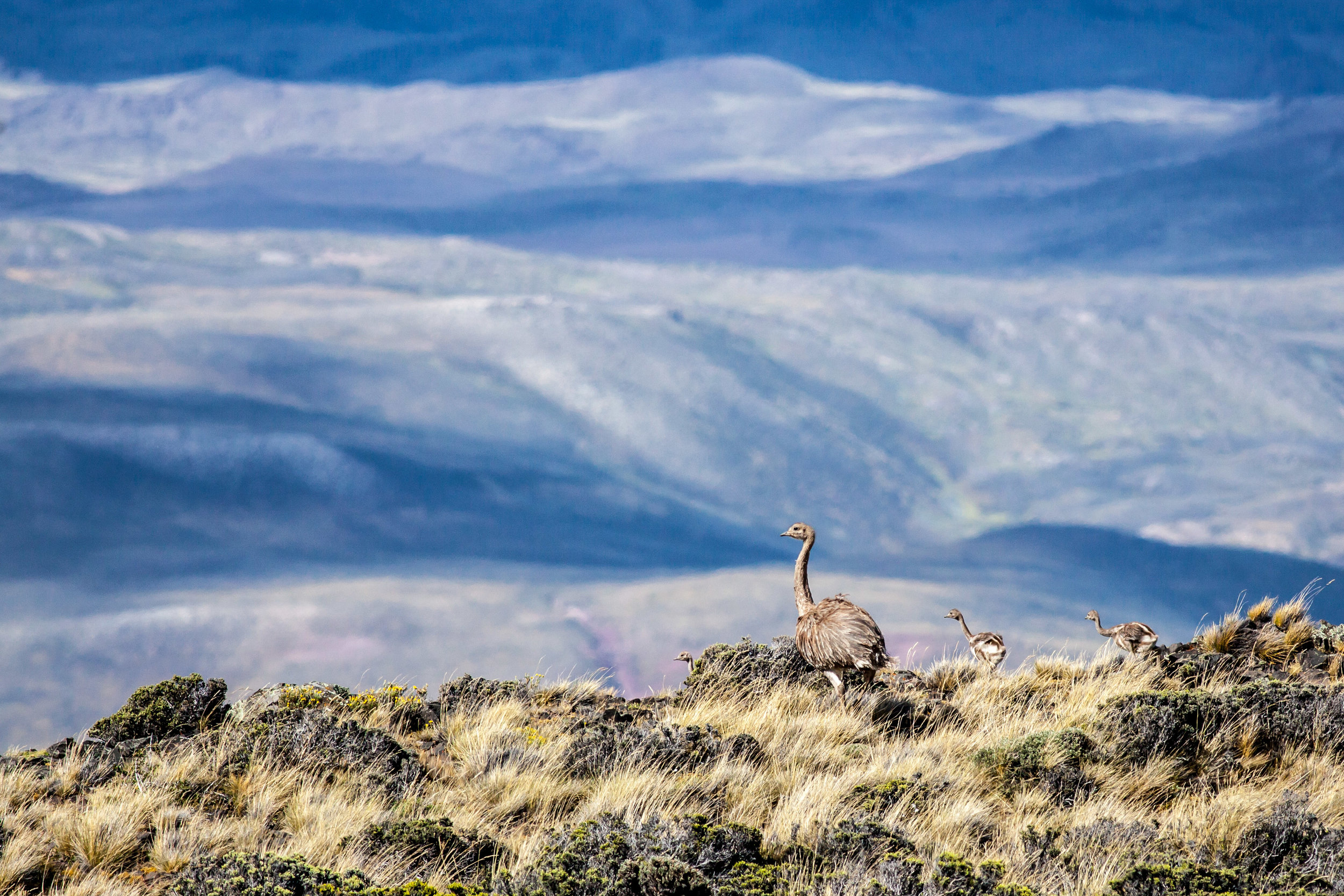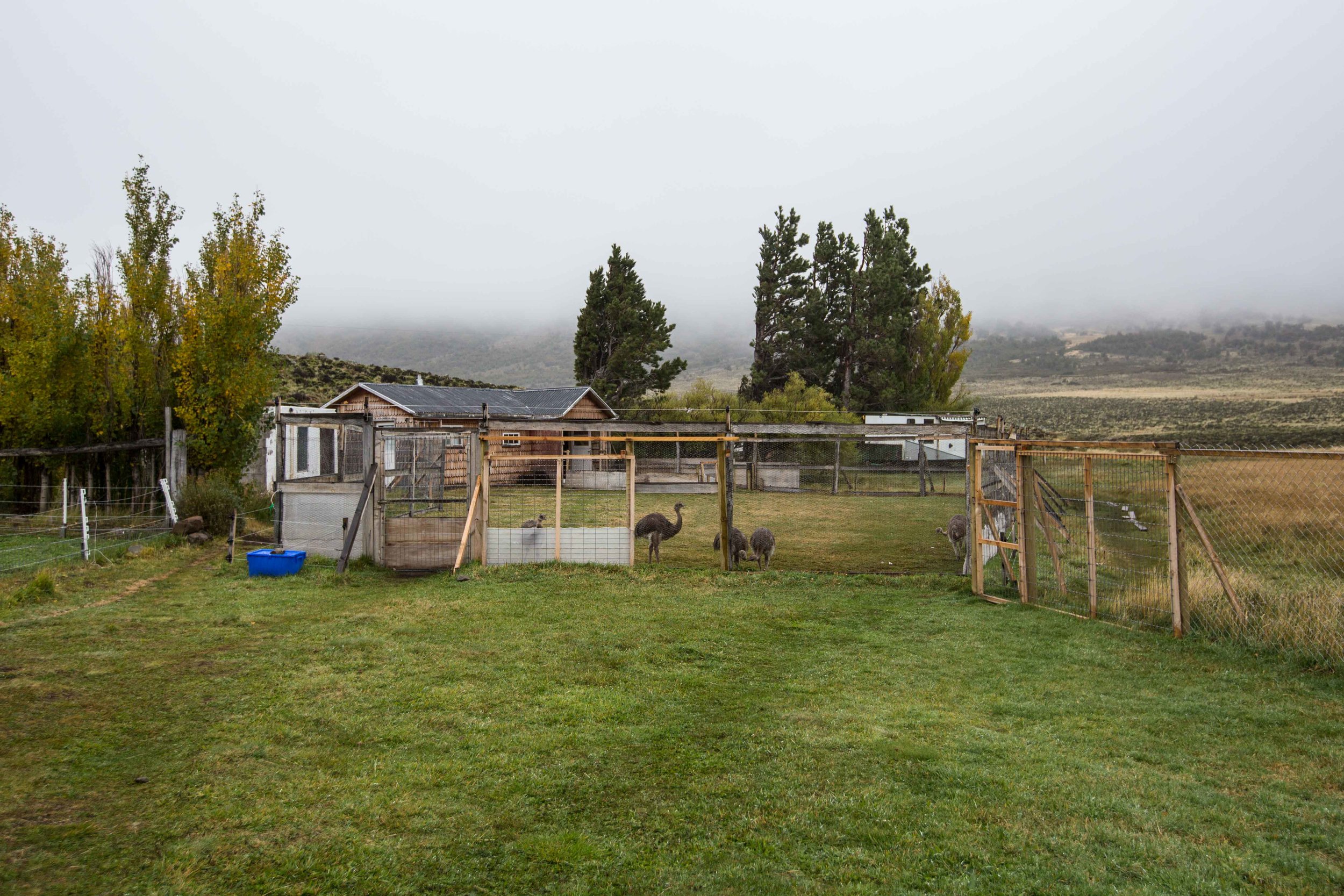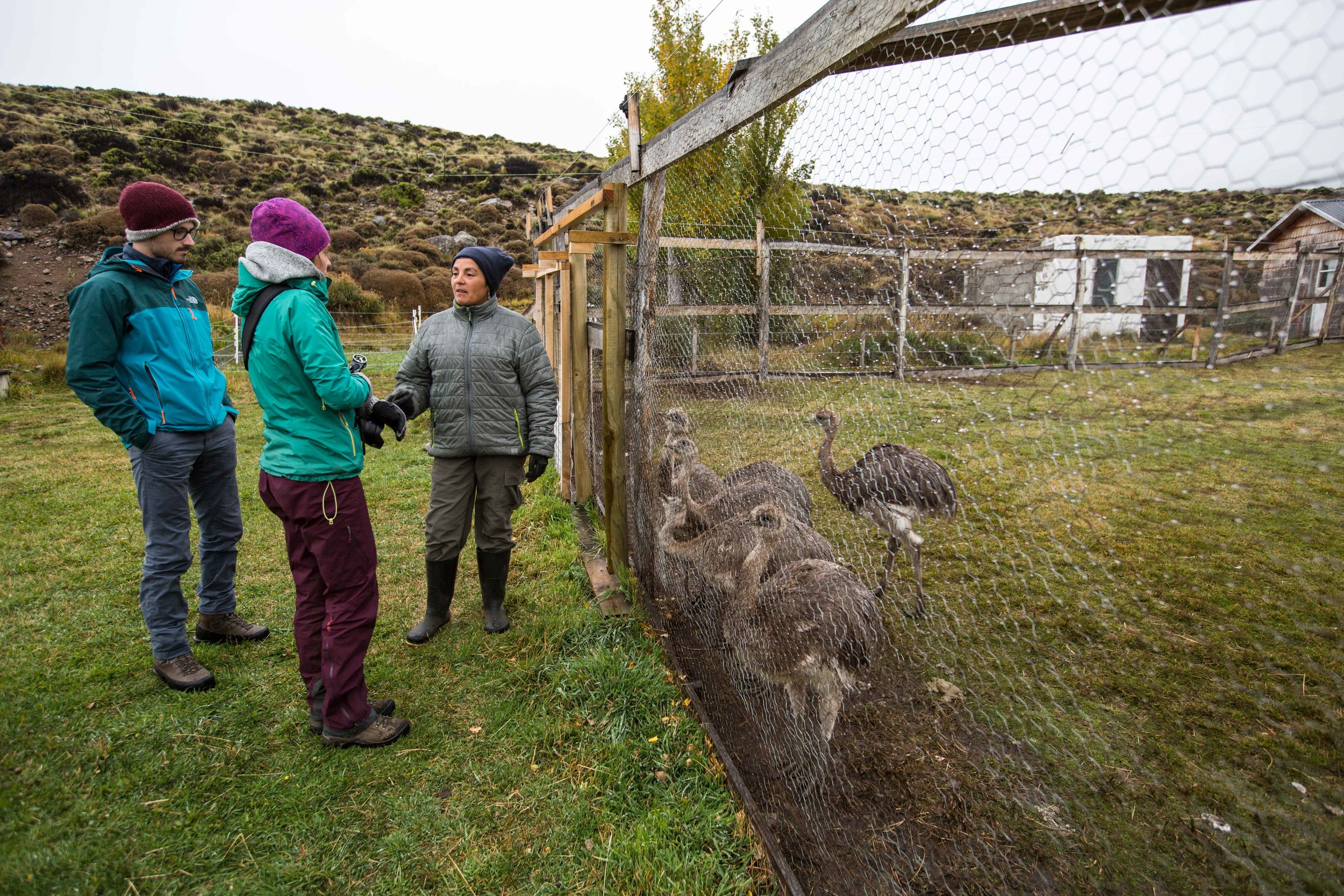BRINGING BACK THE DARWIN’S RHEA: Wildlife Conservation in the Future Patagonia National Park
Text: Andreea Lotak; Photos: Justin Lotak · 16 min read
A male Darwin rhea/ñandú with two of its chicks in Patagonia Park
Across the world there are growing numbers of conservation projects that are seeking to restore ecosystems and to bring back or prevent extinction of native species. Usually, nature, when given the chance, takes care of these processes over time. Sometimes the sensitive matter of bringing back a species or keeping it from disappearing cannot be left to the odds. While in the Chacabuco Valley, Conservacion Patagonica’s contribution to the future Patagonia National Park, we had the opportunity to visit their Darwin’s rhea breeding center. This is where a conservation program was developed to bring back this iconic bird of the Patagonian steppe to an area where it used to roam.
The Chacabuco Valley is typically Chilean Patagonia’s sunny side. However, the morning we were heading to the facilities of the Darwin’s Rhea Conservation Program in the eastern sector of the park, heavy clouds were covering the peaks of the surrounding mountains and rain was falling relentlessly. The truck was winding on the gravel road and in it with us was a new intern from France, Maxime, who was going to spend two months working at the breeding center. The gloomy clouds were making us feel like this landscape was the most isolated place on Earth. As we were approaching the border crossing into Argentina, the truck took a turn and soon stopped in front of the small house known as Puesto Ñandú, or the Ñandú Outpost (in Spanish the Darwin’s rhea is known as the ñandú). Outside there were several enclosures from where curious rheas were trying to figure us out.
First, some background on this charismatic bird: in English it’s known as Darwin’s rhea, following the tradition of the many other species of animals across South America that have been officially introduced to European science by Darwin. As we learned during our visit, there are two subspecies in Chile: the Rhea pennata pennata which is the ñandú of the Patagonian steppe, and the Rhea pennata tarapacensis which is the suri living up north in the Chilean Altiplano (Andean Plateau). The ñandús are gregarious beings and often hang out in groups as large as 30 or 40 individuals. In an interesting twist, it’s not the female that raises the chicks, but the male. Not only is he taking care of chicks from one female, but from several females that leave him behind with the eggs. The picture at the top of the article was captured by Justin several years ago when he came to volunteer in the park and was taken on a trip to this sector. At the time he was unaware that he was spotting a rare sight of a male with his three chicks. The chicks, as we were going to learn, didn’t have more than 2 months at the time of the picture. In Valle Chacabuco there are only 30 individuals left in the wild, roaming in the 3,000 hectares of the eastern sector of the park.
"Our focus is to reintroduce the ñandú into the wild and to increase the local population"
Arriving at the outpost, Alejandra Saavedra, park warden and coordinator of the breeding center, welcomed us warmly, making up for the biting cold. With the recorder on, we started following her around the facilities where we got a boost of energy from her enthusiasm. The center covers over 2,000 square meters and the five enclosures host 22 chicks and juveniles and six reproductive adults. The Ñandú Conservation Program started in 2013 with monitoring the individuals in the wild, setting up camera traps and assessing the situation. After recent studies it was confirmed that this area of the park used to be ñandú habitat. The friendly practices of the former land owner in this smaller, eastern pocket alone maintained a small population, but the species disappeared from the lands of the large sheep and cattle ranch. In 2014 two chicks were rescued by “carabineros”, the Chilean police, and in agreement with wildlife authorities (SAG) decided to bring them to the park. Therefore, in early 2015 the breeding center officially started its work. Soon after more individuals followed. “Are there other programs that are similar and have done something like this with the ñandú in Chile or in Argentina?”, we ask. “Yes, but the focus is entirely different. Our focus is to reintroduce the ñandú into the wild and to increase the local population. Everything that is being done in Argentina and partially in Peru and Bolivia has mostly an economic motivation, revolving around the meat consumption or around using the feathers. There isn’t anything that is focused on conservation.” All the more exciting for us to be able to see this.
As we walk and talk about the program, big snow flakes start falling down. “The first snow of the season!”, exclaims Alejandra happily. We find out that the first individuals will be reintroduced into the wild after the winter, “because winters here are harsh”. The breeding adults that were brought to the center will remain in captivity, in accordance with the guidelines of the national Agriculture and Livestock Service and they will represent the nucleus of this new population. A few of the youngest chicks we see, which are around 5 months old, were incubated at the center and, based on observations, Alejandra estimates that they are more robust than they would typically be in the wild at this age. Same goes for the adults, which normally weigh up to 25 - 30 kg.
Working at the breeding center and monitoring the ñandús’ behavior has led to observations which could easily turn into an extensive study, as unique in its nature as the project itself. Alejandra and the rest of the team led by Cristián Saucedo, the Director of Wildlife Conservation for Conservacion Patagonica, have observed that the legs and the head of the ñandús are their most exposed parts to severe injuries; they are temperamental animals that can easily panic, that lose sight of their surroundings when they get scared, and that seem to have excellent vision during the day, but very poor eyesight at night. Alejandra even suspects that they might be blind in the dark, based on what they have witnessed on the footage captured by cameras set up in the enclosures. As there are no detailed studies on the matter, however, it’s all left to assumptions.
"Males are different because they vocalize. It’s special, it sounds like a tuba. They stop, extend their necks and start making sounds"
One of the males looking photogenic in front of Justin's camera. The ñandú is Patagonia's largest terrestrial bird species, but it is significantly smaller than the ostrich with which it is related.
“Sexual maturity in the wild is reached around the age of three. There are no clear morphological differences between females and males except during the reproductive cycle. Males are different because they vocalize. It’s special, it sounds like a tuba. They stop, extend their necks and start making sounds. This vocalization seems like an introduction to the others, to say ‘this is where I am’. Then they make another sound, which we hear when they get angry or bothered. It’s more like an air blow. It’s funny. Also, when they mate or after mating, we’ve heard them do a sound that comes from their chest and is similar to a small drum.” There are a lot of really interesting facts that we learn from her as the snow starts to settle on the ground and the ñandús approach us inquisitively. The males are all raising chicks and Alejandra points out one of them who seems to be able to differentiate human genders and gets aggressive around men. Then she shows us the star, a young male who was a bit over a year old and who was already the proud father of five chicks. “In a top ten he is our number one”, laughs Alejandra. They put him as a juvenile next to four males and one day they heard him vocalizing like the others did during their reproductive period. In disbelief, the team decided to move the youngster with the group of females to separate him from the males that could hurt him. Soon enough he charmed the ladies and from the romance with several of them he was left with a few eggs from which he ended up raising five healthy chicks. “He is a juvenile that grew up in the center. He’s very calm, he doesn’t panic as much. We like him a lot.”
Since there are no similar projects in the region from which to learn, they have discovered a lot of such fun facts by just being in the facility and working with the birds. During the mating season it gets crowded in the enclosures because males are very territorial and have to be separated. Alejandra assumes that they are not a species that is built to engage in fights and has witnessed a lot of awkward moments of very clumsy attacks. A reason, she thinks, is because in the wild they don’t get to run into one another often. The vast expanses of the Patagonian steppe are more spacious than the enclosures, but her team is doing its best. During the field monitoring trips, Alejandra and the team have explored all 7,400 acres (3,000 ha) and everywhere they’ve seen signs of the 30 ñandús that reside in the area, often following set trajectories that are repeated. From it they have deduced that each individual covers plenty of ground on a regular basis. Plus, often during the day the ñandús at the breeding center were seen running and taking sharp turns as to practice. Adults can run up to 70 km/h and use their wings and necks for agility and balance. In the wild, though, the mortality of the chicks is very high and that is one reason why the team prefers to release them from the breeding center after they reach an age where most of the natural threats are eliminated. Both Alejandra and Cristián confirmed that it’s very likely that ñandús are on the puma’s menu and their chicks are also eaten by foxes and pampas cats. As far as the birds’ diets go, they are mainly herbivorous, thus contributing to the health of the steppe ecosystem. Occasionally, though, they reach out for insects, a lizard or a frog.
“Have you spoken to Cristián as well about the program?”, asks Alejandra as we return to the house once the snow and the cold push us in. Cristián was the one who arranged for us to travel to the breeding center from the park’s headquarters, as part of writing this story, and he is Conservacion Patagonica’s Director of Wildlife Conservation. He has led all the conservation programs in the park since its inception and managed the whole transition of the land from an overexploited and overgrazed livestock ranch to a restoring ecosystem in a future national park.
“The idea of the program is to supplement the local population and to release individuals from the breeding group within the park. Our purpose is to reach a healthy population of 100 individuals in the wilderness within the eastern side of the park”, Cristián told us in his office a couple of days prior to our trip to the breeding center. “We’ve worked a lot. We’ve studied, we’ve learned, we’ve had difficulties, but we keep advancing. We have it clear what the target at the end of the road is, but which road to take is unclear. It’s a learning process and there is a lot of energy that goes into the program. We’re trying to avoid the local extinction of the species. Overall the ñandú is not an endangered species like the huemul. They are in a less threatened category, but their population tendency is negative. In the whole region of Aysén there are no populations located within protected areas; the only other significant population in the same region is located on the land of a large sheep ranch. We’re working so that we can establish a viable population within a protected area, the future national park. If we manage to increase this population, overcome the sensitive number of 50 individuals and get closer to the target number of 100, we’ll be more comfortable that the species will survive here.” He also spoke about the costs of the program, which go up to around USD $30,000 annually. “The benefits considerably outweigh the costs. This season we’ve had very good results that have surpassed our expectations and managed to raise 23 chicks.”
Photo taken moments before the snow and the cold pushed us back into the house where we continued the interview
"You will be isolated with no phone connection, no internet, you’ll only come down here to the headquarters every 12 days at best"
The project has succeeded in following its goals with two permanent workers and the interns that come for one or two months at a time. “Work here mainly has to do with the maintenance of enclosures, the monitoring of camera traps, and with observing the local population. Just two people aren’t enough, so interns are very helpful. This place can never be unsupervised in case of any event; there always has to be someone at the facilities”, Alejandra tells us.
Through the intern program they are looking to bring people whose studies or work have something to do with the nature of the ñandú program and with conservation, as a more committed type of volunteering. Cristián has a very realistic approach when speaking of the internship: “We want people who come here to be aware of the reality. I think it’s important to not romanticize the work that would be done and where it would be done. You will be isolated with no phone connection, no internet, you’ll only come down here to the headquarters every 12 days at best. You’ll have to clean bird poop, feed the ñandús, give them water, clean the place, cut pasture. It’s also important to understand, though, that the person who does these chores is building on the path towards achieving the goal of the program. Their work is as important as any, but the wrong expectations can make it difficult.”
*
As we left Alejandra, her small team of two interns, and the ñandús behind at the little isolated outpost, the vivid green and yellow of the steppe vegetation was contrasting with the freshly fallen snow, giving the landscape a sort of eerie beauty. The hope that one day wild ñandús will be crossing this landscape again made it all the more special.
The first snowfall of the season contrasting with the beautiful, green vegetation of the steppe at the isolated Ñandú outpost (photo by Andreea Lotak)


















On a land destined to be logged, some of the most pristine valdivian temperate forests are now protected by this Nature Conservancy reserve. With its rugged coasts, ancient trees, impressive sand dunes, and local culture, it is a beautiful place to explore. Interview with Liliana Pezoa, administrator of the reserve.